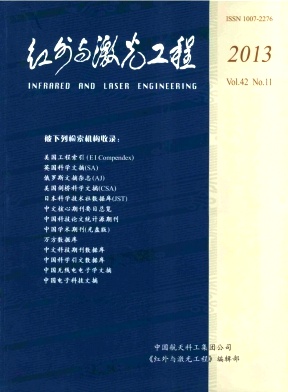Li Xin'e, Ren Jianyue, Lv Zengming, Sha Wei, Zhang Liguo, He Bin. Fusion method of multispectral and panchromatic images based on improved PCNN and region energy in NSCT domain[J]. Infrared and Laser Engineering, 2013, 42(11): 3096-3102.
| Citation:
|
Li Xin'e, Ren Jianyue, Lv Zengming, Sha Wei, Zhang Liguo, He Bin. Fusion method of multispectral and panchromatic images based on improved PCNN and region energy in NSCT domain[J]. Infrared and Laser Engineering, 2013, 42(11): 3096-3102.
|
Fusion method of multispectral and panchromatic images based on improved PCNN and region energy in NSCT domain
- 1.
Changchun Institute of Optics,Fine Mechanics and Physics,Chinese Academy of Sciences,Changchun 130033,China;
- 2.
University of Chinese Academy of Sciences,Beijing 100049,China
- Received Date: 2013-03-11
- Rev Recd Date:
2013-04-13
- Publish Date:
2013-11-25
-
Abstract
A fusion method of multispectral(MS) and panchromatic(PAN) images based on improved Pulse-Coupled Neural Network(PCNN) and region energy in Nonsubsampled Contourlet Transform(NSCT) domain was proposed. Firstly, the two original images were decomposed into a low frequency subband and more bandpass directional subbands by NSCT. Then, for the low frequency subband coefficients, an adaptive regional energy weighting image fusion algorithm was presented; while for the bandpass directional subband coefficients, based on improved PCNN, the bandpass directional subband coefficients was used as the linking strength. After processing PCNN with the linking strength, new fire mapping images were obtained. The fire mapping image region energy was calculated, and the fusion coefficients were decided by the compare-selection operator with the fire mapping image region energy. Finally, the fusion images were reconstructed by NSCT inverse transform. The experimental results show that, when the numbers of iterations are 100 times, respectively as comparing with that of improved wavelet method, Contourlet method and NSCT method: the standard deviation increases by 9.48%, 9.73% and 3.84%; the entropy by 0.95%, 0.94% and 3.34%; the correlation coefficient by 21.56%, 11.27% and 7.89%, and the deviation index reduces by 29.66%, 9.45% and 7.42%.
-
References
|
[1]
|
Do M N, Vetterli M. Contoulet: a direction multiresolution image representation[C]//IEEE International Conference on Image Processing, 2002: 357-360. |
|
[2]
|
|
|
[3]
|
|
|
[4]
|
Do M N, Vetterli M. The Contourlet transform: an efficient directional multiresolution image respresentation[J]. IEEE Transactions on Image Processing, 2005, 14(12): 2091-2106. |
|
[5]
|
|
|
[6]
|
Cunha A L, Zhou J P, Do M N. The nonsubsampled Contourlet transform: theory, design, and applications[J].IEEE Trans on Image Processing, 2006, 15(10): 3089-3101. |
|
[7]
|
|
|
[8]
|
Jia Jian, Jiao Licheng, Sun Qiang. The nonsubsampled contourlet transform in multisensor images fusion[J]. Acta Electronica Sinica, 2007, 35(10): 1934-1938. (in Chinese)贾建, 焦李成, 孙强. 基于非下采样Contourlet变换的多传感器图像融合[J]. 电子学报, 2007, 35(10): 1934-1938. |
|
[9]
|
Yang Yuetao, Zhu Ming, He Baigen, et al. Fusion algorithm based on improved projected gradient NMF and NSCT[J]. Opt Precision Eng, 2011, 19(5): 1143-1150. (in Chinese)杨粤涛, 朱明, 贺柏根, 等. 采用改进投影梯度非负矩阵分解和非采样Contourlet变换的图像融合方法[J]. 光学 精密工程, 2011, 19(5): 1143-1150. |
|
[10]
|
|
|
[11]
|
Eckhorn R, Reitboeck H J, Arndt M, et al. A neural network for future linking via synchronous activity: results from cat visual cortex and from simulations[C]//Models of Brain Function, 1989: 255-272. |
|
[12]
|
|
|
[13]
|
Roussard R P, Rogers S K, Oxley M E, et al. Physiologically motivated image fusion for object detection using a pulse couple neural network[J]. IEEE Transactions on Neural Networks, 1999, 10(3): 554-563. |
|
[14]
|
|
|
[15]
|
|
|
[16]
|
Wu Zhiguo, Wang Yanjie, Li Guiju. Application of adaptive PCNN based on wavelet transform to image fusion[J]. Opt Precision Eng, 2010, 18(3): 708-715. (in Chinese)武治国, 王延杰, 李桂菊. 应用小波变换的自适应脉冲耦合神经网络在图像融合中的应用[J]. 光学 精密工程, 2010, 18(3): 708-715. |
|
[17]
|
|
|
[18]
|
Guo Ming, Fu Zheng, Xi Xiaoliang. Novel fusion algorithm for infrared and visible images based on local energy in NSCT domain[J]. Infrared and Laser Engineering, 2012, 41(8): 2229-2235. (in Chinese)郭明, 符拯, 奚晓梁. 基于局部能量的NSCT域红外与可见光图像融合算法[J]. 红外与激光工程, 2012, 41(8): 2229-2235. |
|
[19]
|
Yu Xianchuan, Pei Wenjing. Performance evaluation of image fusion quality metrics for the quality of different fusion methods[J]. Infrared and Laser Engineering, 2012, 41(12): 3416-3422. (in Chinese)余先川, 裴文静. 针对不同融合算法的质量评价指性能评估[J]. 红外与激光工程, 2012, 41(12): 3416-3422. |
-
-
Proportional views

-









 DownLoad:
DownLoad: